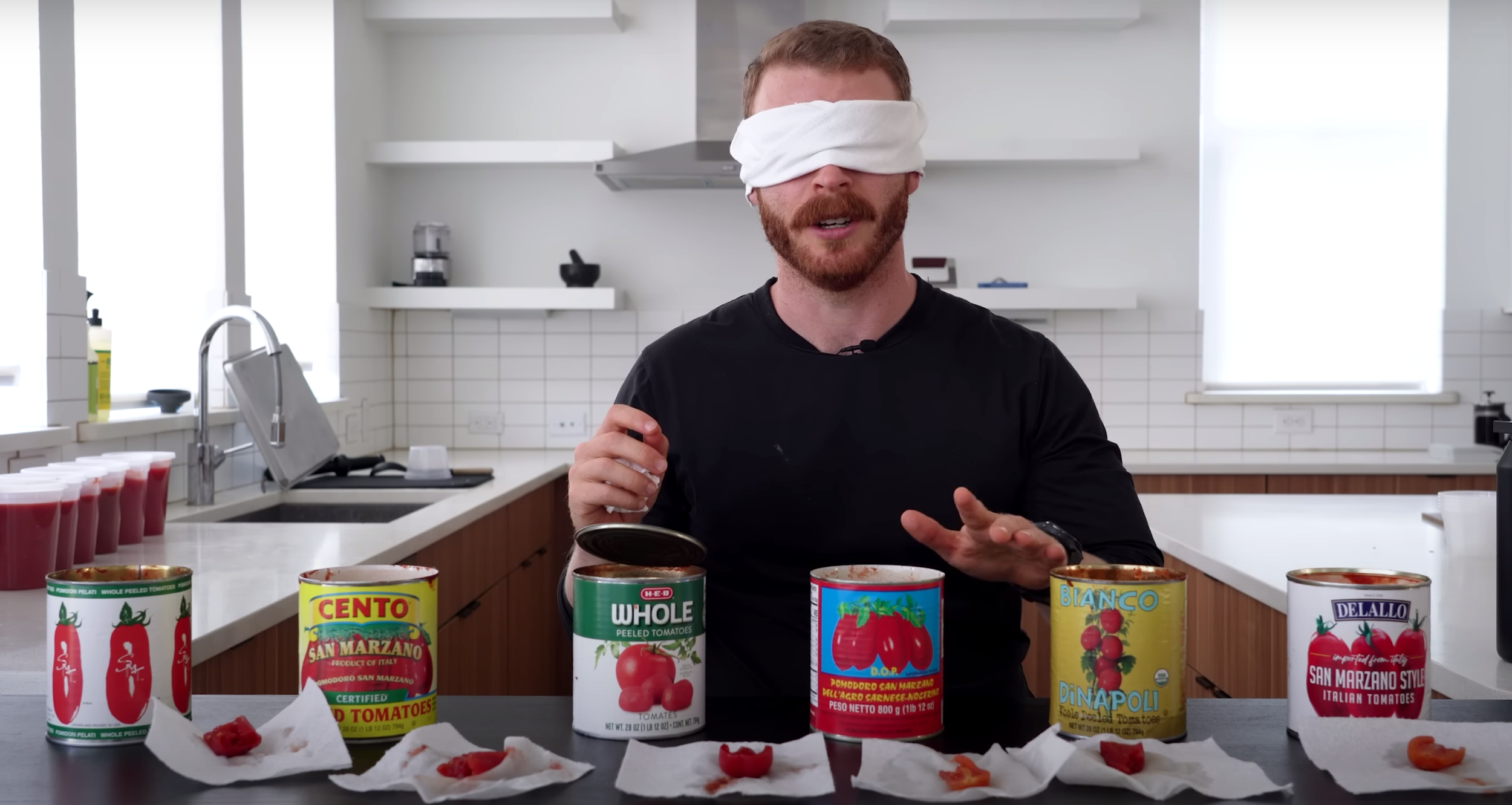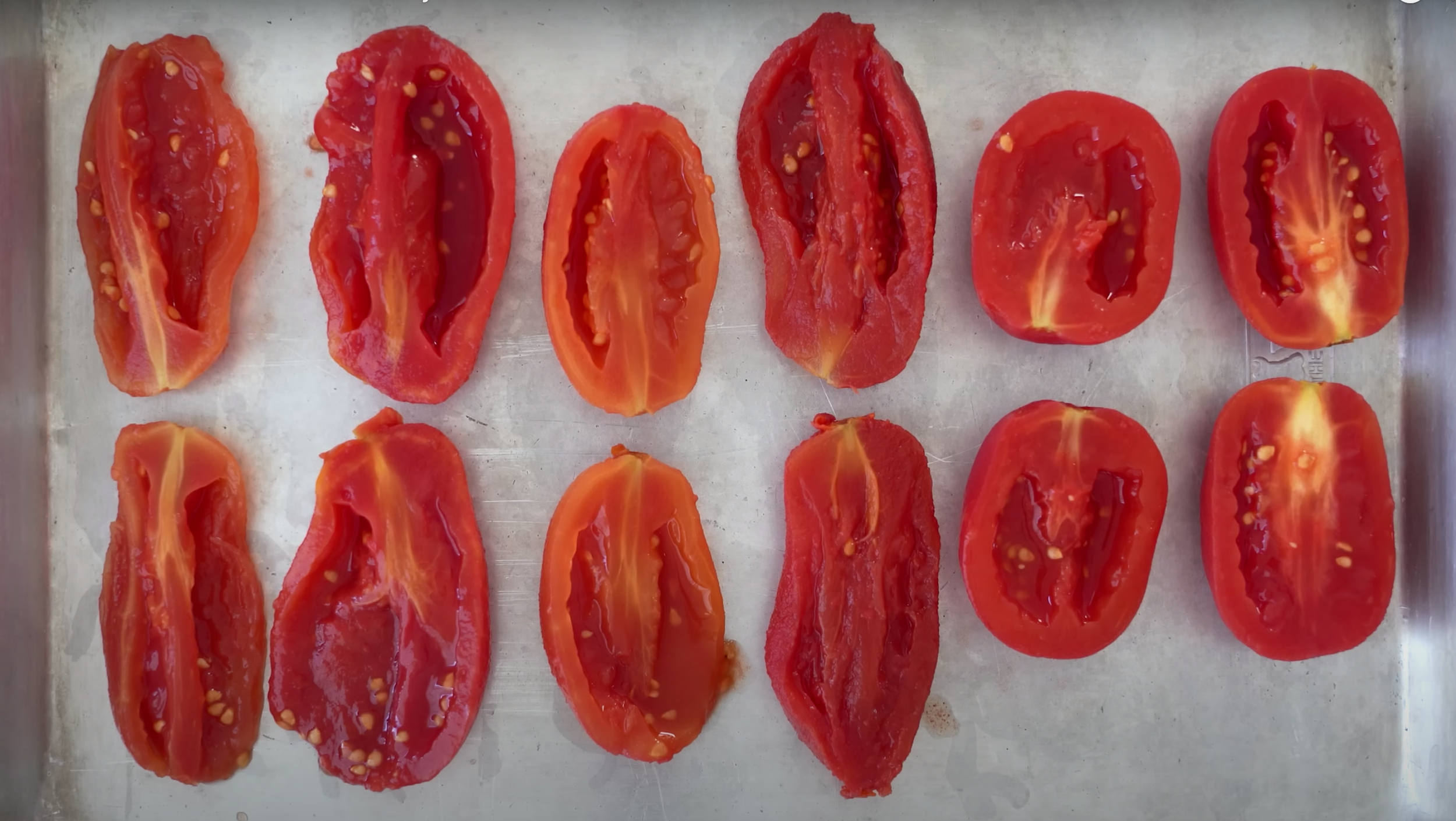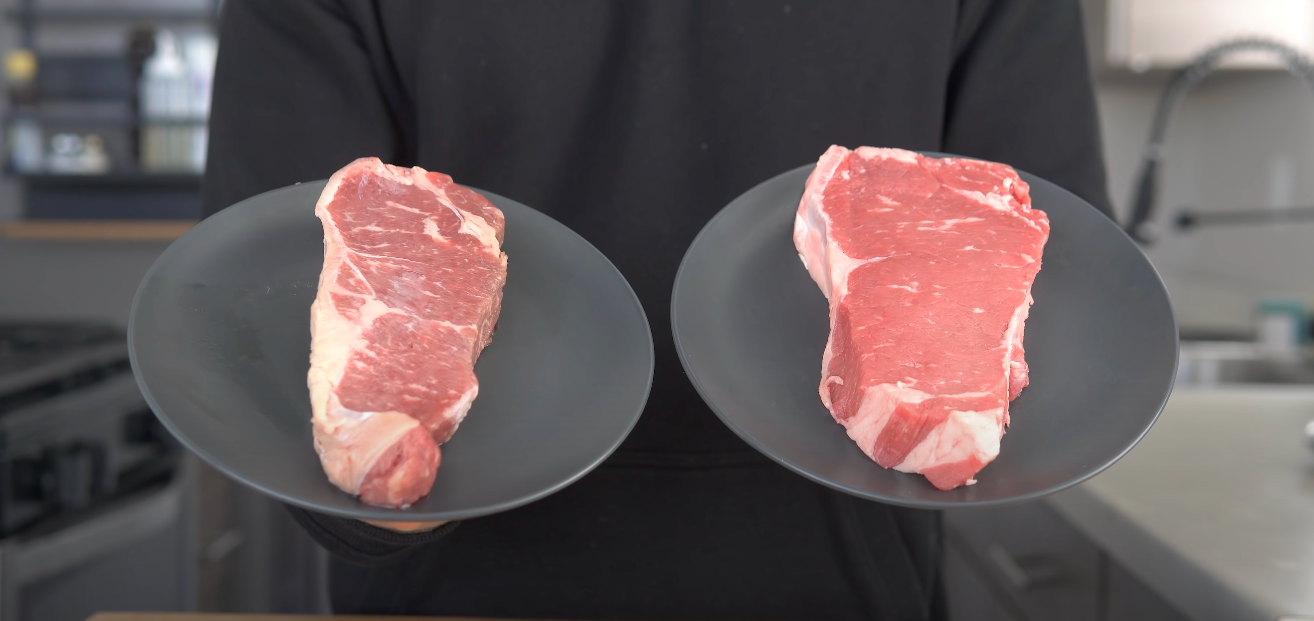Are San Marzano Tomatoes Actually Worth It?
I bought 6 canned tomatoes at varying price points, ingredients, locations, and tomato varieties and ran them through 3 different tests so we can get to the bottom of this.
I have many questions every time I walk down the tomato aisle.
Do I get diced or whole peeled tomatoes?
Are $7 DOP-certified San Marzano actually that much better than a San Marzano-style tomato?
Also what does san marzano style even mean in the first place?
Should I be avoiding tomatoes with calcium chloride on the ingredient list?
And finally, are tomatoes grown and imported from Italy inherently better than the ones grown in the United States?
The problem with many of the existing articles online is that they merely provide subjective flavor reviews of specific brands. What if your palate is different?
Here are two examples that don’t give you enough information for you to make a decision for yourself:
https://www.nytimes.com/article/best-canned-tomatoes.html
https://www.thekitchn.com/the-best-brand-of-whole-canned-tomatoes-you-can-buy-252450
In this article, my goal is to arm you with all the knowledge and terms you need to know so you can strut down the grocery aisle, know exactly what every canned tomato is offering and make a confident purchasing decision for the best pasta or butter chicken you can imagine.
Let’s welcome our test candidates.
Testing Candidates
Here are the 6 cans that will be run through testing:
From left to right
DOP certified San Marzano Tomatoes at $6.30.
CENTO 3rd party Certified San Marzano at $4.69
Dellalo San Marzano Style tomato at $5.79
Bianco DiNapoli (as showcased on Netflix’s Chef’s Table Pizza) at $5.99
San ‘Merican’ Tomato at $4.68
Generic HEB Store Brand at $1.40
Now I didn’t just pick the first 6 cans I saw when walking down the aisle, I actually combed through about 15 cans before choosing these 6 cans to give us a fairly complete look at the canned tomato landscape.
Here are details from each can:
Why Whole Tomatoes?
Your first question might be, why only whole peeled tomatoes?
So on a sliding scale of least processed to most processed these are the typical options at the grocery store
Whole Peeled
Diced
Crushed
Pureed
Tomato Paste, which is a cooked-down and concentrated product
I chose to focus on the whole peeled tomatoes form factor for 2 reasons:
It’s the most regulated
It’s the most versatile for home cooks
Because whole tomatoes are the most regulated, they should be most consistent in the flavor and texture:
Packers generally save their ripest, most attractively tomatoes for the whole peeled cans while Lesser tomatoes are reserved for use in paste, puree, or sauce. (Food Network, Canned Tomato Guide)
Additionally, the ingredients and terms are fairly easy to compare and should also be applicable to a diced tomato or puree from the same brand.
Then in terms of versatility, whole peeled tomatoes can obviously be used whole if needed, but we can also just dice, crush, or puree at home if we please.
Why are Plum Tomatoes Canned?
Now before I get into where the tomatoes are grown, let’s first talk about tomato variety first
Here is one tomato from each of the 6 cans, and as you can see they come in varying shapes and sizes, but what I found very interesting, is that these are actually all plum tomato varieties.
Which then led me to wonder, why are plum tomatoes used for canning?
The reason why the San Marzano or Plum tomatos in general are used is due to their tomato structure which creates great sauces.
Take a look at this picture:
Pic from Eatlocal.org
In general, compared to other varieties, plum tomatoes like the San Marzano have more tomato flesh, fewer seeds, and lower water content, which is ideal for cooking sauces.
The elongated plum shape of the San Marzano means it’s almost entirely tomato flesh, with a very low proportion of seeds and watery juice, unlike the other examples here.
Now interestingly, there are a ton of tomato plum varietals as evidenced by the following chart. Each of them is going to be a little different in terms of taste, texture, and flesh-to-seed ratio.
Now from what I’ve been able to find there are just 3 primary varietals used in the cans we’ll find at the store.
A Roma - The rounder plums found in our generic store brand & San Merican can
A San Marzano - this is the official San Marzano tomato seed used by Cento brand and the DOP-certified tomatoes
A San Marzano style - then lastly is a San Marzano style which is very similar but is some type of seed offshoot from the original
Does Location really matter?
For example, will the exact same tomato (grown from the same seed) taste different if it’s grown in a different location?
If you ask Italy — they will say yes, which is why the DOP certification system was established.
The DOP stamp certifies these tomatoes used the specific San Marzano seed type and were grown in a specific location with proximity to Mount Vesuvius.
It’s important to note that different does not mean better. For example, it could be true that San Marzanos are sweeter, but you may not like that in your tomato sauce.
But most articles or videos online will immediately recommend the San Marzano variety over the generic plum options.
So why exactly did the San Marzano become the most popular?
The two main arguments are that San Marzanos are:
Sweeter and less acidic than other canned tomatoes
The gold standard for meaty flesh-to-seed ratio
I sliced open each tomato down the line and here they are, now I’ll let you decide, but while cutting them it definitely seemed like the 2 Roma varieties (on the right) let out more tomato water than the 4 San Marzano types (on the left).
This could affect both the taste and texture of cooked sauces, which we’ll test, but first I went ahead and tried each tomato raw.
Noticeable Taste Difference with added Calcium Chloride
So outside of maybe using canned tomatoes for salsa or a raw tomato sauce for a Neopolitan pizza, this may not be the most applicable test. However, I’m glad I did it because there was a kind of an off-putting texture I kept noticing while handling and tasting them: the Roma tomato varieties were overly firm.
Now Roma tomatoes might be a little firmer than San Marzanos in general, but these were noticeably firm and I found out that is likely the result of one ingredient added to the tomatoes, calcium chloride.
Calcium chloride is a common firming agent used in a variety of canned vegetables, and for tomatoes, it keeps them intact during packing but also during cooking.
Now obviously, I can just blend up the tomatoes before cooking so maybe the firming agent isn’t a big deal if I want a smooth sauce, but the calcium chloride tomatoes definitely had a tinny, metallic, and sour flavor.
Other Added Ingredients
This is also a good time to bring up all the potential ingredients you can see on a tomato can label.
These are:
The Whole Tomato (Roma, San Marzano, San Marzano Style)
Tomato Juice (or Puree) used to pack around tomatoes
Salt
Calcium Chloride
Citric Acid used as an acidity regulator
Flavorings (like Basil)
Now salt and added flavorings are pretty obvious, and we touched on what calcium chloride does.
But why is citric acid added?
Citric acid is added to ensure the PH of canned tomatoes is safe for canning — it needs to be acidic enough to prevent bacterial growth. Often tomatoes are canned with added water weight, which means more citric acid is needed to get the PH back to the right level.
Additionally, tomatoes naturally vary in PH depending on variety and ripeness. Adding citric acid allows brands to ensure consistent PH across batches, which also be used to control the flavor.
PH Test
I actually got a ph meter, pureed each can of tomatoes, and then took the ph for each batch. All of them ended up being within a tenth or two of each other, but the Italian imports were consistently less acidic:
PH of each canned tomato (raw):
DOP - 4.3
Cento - 4.3
Delallo - 4.2
San ‘Merican’ - 4.1
Bianco - 4.0
HEB - Generic - 4.0
Now, I wouldn’t read too much into this from a taste perspective, because during the raw test I thought the Bianco was on the sweeter side even though it had the lowest ph of the bunch. Human palates might not always perceive sweetness or acidity the same as the actual PH levels of food
Sauce Taste Test
For me, it was important to test my favorite tomato sauce I make at home with each can
I made 6 identical batches of Marcella Hazan’s 3 ingredient sauce, which ended up being
300 grams of the blended tomatoes
25 grams of butter
1/8 of an onion
and 2 grams of salt.
Additionally, these were all cooked in the same pot, set on a 30-minute timer at a consistent 205 degrees F on a Breville Control Freak induction burner. This is the most consistent I could possibly replicate at home.
I also ensured the temperatures were the same at tasting time
Conclusions
So while I liked the tomato-forward San Marzano-style tomato from the Delallo brand the best, that’s actually not my main takeaway.
There is a significant upgrade in the San Marzano-style and San Marzano certified tomatoes, but I actually don’t think it’s just from the tomato type.
The two canned tomatoes that I really was not a fan of, although both Roma tomatoes and the only cans that had calcium chloride added, were also the only cans that were packed in watery tomato juice.
Importance of Tomato Packing Juice
I think the liquid that tomatoes are packed in is very important and a little confusing.
If you take a look at the ingredient label of the generic, San Merican, Bianco, and Dellallo brands they all list ’tomato juice’ on the can while the Cento and San Marzano both say tomato puree.
So you would think that all 4 of these should be packed in a similar viscous liquid, but that’s actually not the case.
Once you open up each can and take a look, the Bianco and Dellallo brands are packed in a noticeably thicker puree (just like the San Marzano varieties) while the generic and San Merican are packed in basically all water.
This is important for 2 reasons:
A puree-like substance has more tomato flavor than a watery liquid
It cooks down into a thicker sauce instead of a watery one.
This was something I noticed immediately in the test since I cooked each sauce for 30 minutes. The 4 cans with the puree-like substance were noticeably thicker and in my opinion, created just a flat-out better texture.
Now to avoid this, obviously, you could cook the sauce down a lot more or you could pour off some of the juice before even cooking, but provided you achieve the same thickness, you are wasting some of what you paid for and ending up with less sauce than with a different can.
So, after this test, my takeaway is to avoid cans with calcium chloride and watery tomato juice.
Cooking Test #2 - Butter Chicken
Because we’ve only tested a basic tomato sauce I’m wondering: are these flavors that I did not like still going to be prevalent in a heavily spiced dish?
So I could have made chili, shakshuka, or countless options, but I was in the mood for some butter chicken.
This is in no way a super traditional recipe, but I made a quick spice mix with:
1 part garam masala
1 part turmeric
1/3 part garlic powder
1/3 part coriander
1/2 part cayenne powder
1 part cumin.
Then I threw some chicken breast that was marinated in yogurt and the spice mix on a hot skillet.
Once that was cooked I prepped 6 identical batches of sauce.
I took 100 grams of the cooked tomato sauce and add 2 grams of the spice mix, 5 grams of butter, and 50 grams of heavy cream before mixing that up and letting it bubble, lastly I tossed 50 grams of the cooked chicken to stew down.
Again, I tried to keep the temperature right around 120 F for eating.
These are the main questions I had before coming into this taste test:
Are the 2 acidic and metallic-tasting cans still noticeable?
Will I like the same can for this test, or is this a new canned tomato that is best suited for this use case?
So after this test, while the water tomato and calcium chloride weren’t as bad, there was still a noticeable difference in the 4 San Marzano cans just like before
Interestingly, while I praised the tomato-forward taste of the Delallo can in the tomato sauce test, I actually didn’t like that attribute in the butter chicken test. Instead, I found something truly addictive with how the Cento brand tomatoes married with the spices and heavy cream.
This was just personal preference, however, and my point is that you’ll have to experiment to find what you like best for different applications. For example, after testing, maybe I keep a can of the Bianco for a raw application, I’ll use the Delallo for my pasta or pizza sauce, but then I’ll use the Cento for a butter chicken or cream-based sauce like pasta alla vodka.
Final Recommendations
So in conclusion, I hope you realize this isn’t about identifying a specific brand at all.
Rather, I want you to understand all the terms and knowledge around tomato types, growing locations, and added ingredients for yourself, so can confidently make an informed decision next time you buy.
With that being said, here is how I would recommend shopping for canned tomatoes:
Avoid cans with calcium chloride added.
Find cans packed in tomato puree. Remember, even if it says tomato juice, sometimes it may still be a thicker puree, so you’ll just have to open it up and see.
Look for cans with the plum varietal specified as San Marzano or San Marzano Style
Lastly, pick 2 or 3 cans and experiment for yourself with taste tests for varying applications.
If you want to watch my full video on this and see my live taste test reactions, check that out:
Sources
Canned Tomato Guide & Term Explanations:
https://www.foodnetwork.com/recipes/articles/canned-tomato-guide
USDA Canned Tomato Regulations: https://www.ams.usda.gov/sites/default/files/media/Canned_Tomatoes_Standard[1].pdf
Plum Tomato Comparison Chart: https://www.johnnyseeds.com/growers-library/vegetables/tomatoes-paste-plum-roma-comparison-chart-pdf.html
Further Reading:
Tomato Variety Differences: https://www.eater.com/2019/8/21/20813778/whats-the-difference-between-heirloom-cherry-grape-beefsteak-plum-tomatoes
What does D.O.P mean? https://www.seriouseats.com/what-is-a-dop-italian-san-marzano-canned-tomato



















